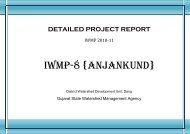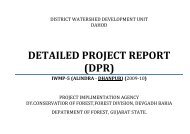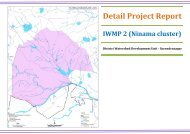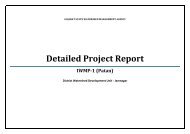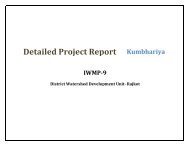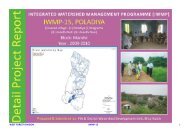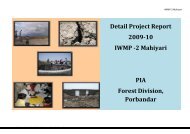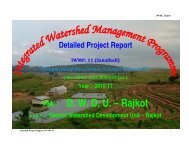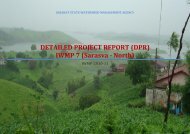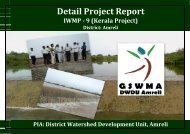IWMP-11 - Commissionerate of Rural Development Gujarat State ...
IWMP-11 - Commissionerate of Rural Development Gujarat State ...
IWMP-11 - Commissionerate of Rural Development Gujarat State ...
You also want an ePaper? Increase the reach of your titles
YUMPU automatically turns print PDFs into web optimized ePapers that Google loves.
PIA: DWDU, Amreli<br />
Vermicompost Unit<br />
One <strong>of</strong> the important occupations <strong>of</strong> the villagers is animal husbandry. At present, the animal waste is not used by the villagers as<br />
agricultural input. If the farmers start realizing the benefits <strong>of</strong> compost and vermicompost in particular, the productivity <strong>of</strong> their land can<br />
increase manifold. As part <strong>of</strong> direct livelihood support, the villagers (mainly land less) are going to receive cows, buffaloes and small<br />
ruminants. These animals in turn are going to produce more waste, which can be used to prepare vermicompost.<br />
It is planned that a vermicompost unit by another SHG would be supported by the project. The SHG members, with the help <strong>of</strong> hired<br />
manpower, can collect animal-dung. They would process this dung to prepare vermicompost and sell it to the farmers in the village or<br />
outside, as per demand. The process <strong>of</strong> composting crop residues using earthworms comprise spreading the agricultural wastes and cow<br />
dung in layers <strong>of</strong> 1.5 m wide and 0.9 m high beds <strong>of</strong> required length. Earthworms are introduced in between the layers @ 350 wo rms per<br />
m3 <strong>of</strong> bed volume. The beds are maintained at about 40 - 50% moisture content and a temperature <strong>of</strong> 20 - 30o C by sprinkling water over<br />
the beds. The earthworms being voracious eaters consume the biodegradable matter and give out a part <strong>of</strong> the matter as excreta or vermicastings.<br />
The vermi-casting containing nutrients are rich manure for the plants.<br />
About The Worms<br />
Eisenia fetida, Eudrilus eugeniae, and Perionyx excavatius are some <strong>of</strong> the species for rearing to convert organic wastes into manure. The<br />
worms feed on any biodegradable matter ranging from coir waste to kitchen garbage and Vermicomposting units are ideally suited to<br />
locations / units with generation <strong>of</strong> considerable quantities <strong>of</strong> organic wastes. One earthworm reaching reproductive age <strong>of</strong> about six weeks<br />
lays one egg capsule (containing 7 embryos) every 7 - 10 days. Three to seven worms emerge out <strong>of</strong> each capsule. Thus, the multiplication<br />
<strong>of</strong> worms under optimum growth conditions is very fast. The worms live for about 2 years. Fully grown worms could be separated and<br />
dried in an oven to make 'worm meal' which is a rich source <strong>of</strong> protein (70%) for use in animal feed.<br />
District Watershed <strong>Development</strong> Unit, Amreli 59



